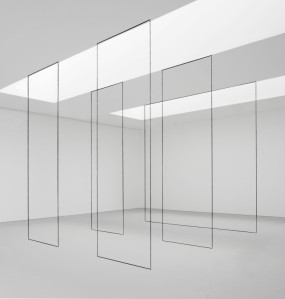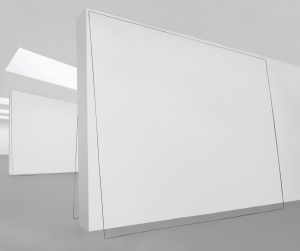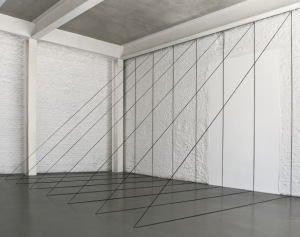In this post, I start with verse from Dakshinamoorthy stotram, and the influence it had in my understanding of John Cage’s 4.33, Fred Sandbacks string sculptures and how this in turn has lead to my germinating two creative ideas.
Absence of Words
The very first verse of Dakshinamoorthy stotram (Composed by Adi Shankracharya) avers in a very profound manner that the ultimate reality (Brahman) is beyond words. Here is the verse in Sanskrit, followed by English along with the meaning and commentary.
मौनव्याख्या प्रकटित परब्रह्मतत्त्वं युवानं
वर्षिष्ठांते वसद् ऋषिगणौः आवृतं ब्रह्मनिष्ठैः ।
आचार्येन्द्रं करकलित चिन्मुद्रमानंदमूर्तिं
स्वात्मारामं मुदितवदनं दक्षिणामूर्तिमीडे ॥१॥
Mauna-Vyaakhyaa Prakattita Para-Brahma-Tattvam Yuvaanam
Varssisstthaam-Te Vasad Rssigannauh Aavrtam Brahma-Nisstthaih |
Aacaarye[a-I]ndram Kara-Kalita Cin-Mudram-Aananda-Muurtim
Sva-[A]atmaaraamam Mudita-Vadanam Dakssinnaamuurti-Miidde
Meaning:
1: (Salutations to Sri Dakshinamurthy) Whose Exposition through Profound Silence is Awakening the Knowledge of the Supreme Brahman in the Hearts of His Disciples; Who is Himself Youthful
2: … but is Sitting Surrounded by Old and Great Sages who are Devoted to Brahman,
3: The Hands of the Supreme Spiritual Teacher is Forming the Cin-Mudra (gesture of the Knowledge of Brahman) and Whose Appearance is Still and Blissful,
4: Who is Rejoicing in His Own Self which is reflected on His Blissful Face; Salutations to Sri Dakshinamurthy.
Commentary :
I am now quoting from a talk given on this Stotram by Swami Tadatmananda Saraswati :
Quote: The ultimate reality is revealed through a silent exposition. This is symbolic. What could silent teaching mean? Is it possible to express the reality of Brahman in one or two sentences?Is it possible to express the reality of Brahman in one or two books?Any amount of teachings is not adequate to define what is para Brahma.No number of words could ever define the reality; we call Ishvara. Whatever words we use, Brahman is more than that. We truly have to admit that the reality that is para Brahma is beyond words.There is a famous quotation from “Taittiriya Upanishad”. “The reality we seek is that from which words fall back, failing to grasp that reality”. This is very profound Vedantic teaching.An exposition of silence is a poetic way of saying that the TRUTH being conveyed is beyond words, beyond the reach of language. Unquote:
The concept of teaching in silence struck a chord with me and made me reflect on it several times in the recent times. There was something in that verse, that made me go back to it time and again and reflect over its beauty.
INTERMISSION
Absence of Sound
Sometime last year, I was introduced to John Cage’s famous piece 4.33 by Dr Raja Angara, a renowned Sitar player from Hyderabad. Here is the video of a performance.
When I first heard ( or did not hear the piece), I was intrigued with the concept of a Western classical musician performing a silent piece, and researched further on the idea behind this performance. ( Acknowledged as a path-breaking and seminal piece, there is plenty of information/commentary available on the net) .
The best comment on this I could find was by
Quote: Although often described as a silent piece, 4’33” isn’t silent at all. While the performer makes as little sound as possible, Cage breaks traditional boundaries by shifting attention from the stage to the audience and even beyond the concert hall. You soon become aware of a huge amount of sound, ranging from the mundane to the profound, from the expected to the surprising, from the intimate to the cosmic –shifting in seats, riffling programs to see what in the world is going on, breathing, the air conditioning, a creaking door, passing traffic, an airplane, ringing in your ears, a recaptured memory. This is a deeply personal music, which each witness creates to his/her own reactions to life. Concerts and records standardize our responses, but no two people will ever hear 4’33” the same way. It’s the ultimate sing-along: the audience (and the world) becomes the performer. Unquote:
I am taking a small detour from the main theme of my blog, to highlight the role of the possible role of vedanta behind this piece. I am quoting from one the statements made by John Cage:
Quote: And then in the nick of time, Gita Sarabhai came from India. She was concerned about the influence Western music was having on traditional Indian music, and she’d decided to study Western music for six months with several teachers and then return to India to do what she could to preserve the Indian traditions. She studied contemporary music and counterpoint with me. She said, “How much do you charge?” I said, “It’ll be free if you’ll also teach me about Indian music.” We were almost every day together. At the end of six months, just before she flew away, she gave me the Gospel of Sri Ramakrishna. It took me a year to finish reading it.”
To quote another source
“Everyone knows that Gita Sarabhai gave to John Cage the definition of the purpose of music that her teacher had given her: “to quiet the mind and render it susceptible to divine influences.”
Suffice it to say, the intention behind 4.33 was to quieten the mind and render it susceptible to normal sounds, which he felt could also be construed as music. 4.33 was composed by him in 1952.
Watch this video by him.
(Good old Wiki, with their bias, attributes the influence of Zen Budhism to this piece, which is a subject matter of another blog !)
Watching and reading about the piece, I felt connected with John Cage and admired him for his audacity and courage of his conviction to not just ‘write’ a piece like 4.33 but to actually ensure that it was performed with such sincerity and integrity. Remember this was in 1952. I can understand the rebel 70’s to accept such kind of bold departure, but early 50s? How much time would he have had to spend convincing the producers about the uniqueness of such a silent piece, which when heard or not heard can potentially invoke ridicule amongst a conservative audience?
INTERMISSION
Absence of Material
Some time last fall, on my way back to the visit to Storm King, I visited Dia Beacon. For any contemporary art lover, Dia is a veritable treasure house of works by giants.
As I was walking through the gallery absorbing the pieces, I discovered the sculptures by Fred Sandback. Having visited a number of sculpture parks and shows around the world, I am used to experiencing the “aha” moment, but Sandback was, to use a corny phrase ‘the mother of all ‘aha’ moments!
Using something a material as simple as string, Sandback created sculptures that seem to envelope space, giving it a boundary, a border, while simultaneously leaving it open for us to imagine, what that enclosed space could contain. Or you could just see the whole gallery as a sculpture in which strings have been strung in a beautiful pattern, so in a sense the enclosure of the art ‘space” is the walls of the gallery inter spread with strings. So you could experience both the outside as well as the inside of a space.
Here is a selected collection of statements by the artists on his works:
“The first sculpture I made with a piece of string and a little wire was the outline of a rectangular solid . . . lying on the floor. It was a casual act, but it seemed to open up a lot of possibilities for me,” Fred Sandback recalled of a seminal sculpture he executed in 1966. In wanting to create sculpture that did not have an inside, he found the means to “assert a certain place or volume in its full materiality without occupying and obscuring it.”
“Maybe some perverse intentions: I wanted to make something without an interior, at least in the sense of a conventional sculpture which has an interior, an invisible interior; I didn’t want a volume enclosed by a surface. I also wanted a wholeness that was, approximately, not reducible. A wisecrack by George Sugarman about “getting rid of everything” preceded the first piece—though there really wasn’t much connection. There were also endless conversations with the sculptors Dan Edge, Adrian Hall, and Charlie Wilson.”
“Well, the first construction was a depiction of the perimeter of an imaginary volume. It described the edges of a rectangular solid on the floor, two inches high by four inches wide by twenty feet long. A lot of the early pieces had the quality of being a boundary of an object, more or less. They still had a sense of containment that referred to the sculptural object.”
More information on his works can be found at here and here.
I initially reacted to each of his piece individually and kept imagining, what material, what object, what color, would do justice to the space being enclosed by the strings. It was an exercise in ‘collecting everything” and putting it back in the space, what the artist has so beautifully “gotten rid off’! I was trying to inject material into the space created by the artist, even though it was not the intent of the artist! It was in this process, I realized that the beauty in his sculptures was in the absence of the material. The simplicity with which the fragile strings convey this was deeply profound and had a lasting impact on me.
Dia has so many great artists works Serra, Judd, Kawara, Warhol to name a few. Its always difficult to judge one against the other, but Sandback’s work took on a spiritual dimension that resonated very strongly with me and my vedantic background.
INTERMISSION
My own creative and spiritual journey
In all these months, I kept revisiting the first verse of the Dakshinamurthi stotram. There was something in “teaching through silence” that stayed with me and kept haunting me time and again.
There was some understanding, some insight that was waiting to be discovered.
I also kept thinking about Sandback’s works as well as John Cage’s 4.33. I could see there was some connection to be made between the three concepts that were periodically intriguing and engaging my mind.
Then the moment of epiphany happened. I realized that the common theme across all the three was the ‘absence’ of something. The absence of words to teach the truth, the absence of sound to highlight the music in the everyday sounds, the absence of material to highlight the beauty of space, (that we so seem to take for granted).
Parallely, my own inner struggle to express myself creatively began manifesting itself more intensely. I began exploring the concept of ‘absence’ a bit more deeply and tried to take it to other fields of art.
Here are two ideas that I came up with:
A movie with limited visuals
Imagine going to a 90 minute movie and spend 60 -75 minutes staring at a black screen? The whole story moves forward through dialogues, sounds and background score. Three quick story lines could be:
a) Story can be based on the text “Drg Drsya Viveka” which deals with Consciousness (Witness or Absolute Seer), Mind ( Relative Seer-Seen) and Sensory Organs ( Relative Seer- Seen). After listening to ones Guru, the disciple goes through a process of “mananam” and with limited visuals of external world interspersed with darkness as well as visuals of his thoughts and emotions (with no spatial and temporal limitations – like Inception) he understands the teachings in the text. (You can read about the text here)
b) Man is poisoned to be killed, but instead goes temporarily blind. He escapes from his killers and races against time to find an antidote else he will be permanently blinded and killed if the attackers find him. It’s a movie that is a race against time and narrative would be his inner dialogues’, his talking to strangers, familiar sounds and score. Whenever he is talking to strangers, there would be a brief visual of his current location to give a perspective to the audience on his whereabouts.
c) Set in Peru or Cambodia ( for the fans of Jolie) explorer falls into a maze of caves, which have been so structured in the ancient times that the sunlight is visible for five minutes every day when the sunlight passes a particular point. The rest of the day he lives in darkness and has to find himself out of the place.
( Take a small break here and visualise sitting in a theatre for 90 minutes with only 15 -30 minutes of visuals)
The above are three simple ideas, but more ideas can be thought off along these lines. With absence of visuals, the movie will force you to visualize the story through sounds.
An art piece that uses no material
Imagine a yoga studio. People lying in ‘savasana” or sitting in a meditative posture.
The instructor is seated facing the audience. The instructor in this case is not a yoga guru, but an artist.
For the next 30 minutes he will describe his art (painting or a sculpture or an installation). The level of description is completely left to him. He can be vivid and detailed or vague and cryptic. The methodology too would be unique to him following no set pattern or routine.Once he completes his description he can discuss his art with his audience or simply leave, leaving no trace of his art except in the memories of the audience.
No material used. No strings attached. (I mean to the ceiling or the floor :))
Just words describing his work.
The description by the artist and the visualization by the members in the audience will be unique to each one of them. No two members will have the same reaction or the same visualization to the description by the artist.
( Take a small break here and visualise listening to your favourite artist describing his work sitting in a meditative posture)
The above are two of my ideas that had their basis from my understanding of the value of absence. Each one of us can reflect on the value of absence and explore it further in our own unique way. To paraphrase Gita Sarabhai, absence helps you quieten your mind and open itself to creative influences, because for me in creativity there is divinity.
OM TAT SAT
The article has been republished from author’s blog with permission.
Featured Image: Wikipedia




